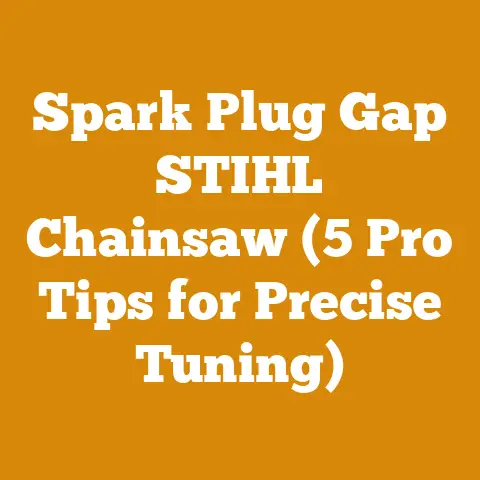Build Your Own DIY Log Splitter (Heavy-Duty H-Beam Power)
Forget store-bought log splitters; let’s forge our own heavy-duty H-beam behemoth! I’m going to walk you through every nut, bolt, and weld of building a log splitter that’ll laugh in the face of the gnarliest hardwoods. I’ve spent years felling trees and processing firewood, and I’ve learned that a reliable log splitter is the backbone of any serious operation.
Why Build Your Own Log Splitter?
For years, I relied on rented splitters or weaker, store-bought models. They were fine for small tasks, but when I tackled larger projects involving dense oak or knotty elm, they always fell short. That’s when I decided to build my own.
- Cost Savings: Commercial splitters can be expensive. Building your own, especially if you can source some materials used, can save you a significant amount of money.
- Customization: You can tailor the design to your specific needs. Want a longer stroke length? A wider beam? You’re in control.
- Durability: By using high-quality materials and proper welding techniques, you can create a splitter that’s far more robust than many commercially available models.
- Satisfaction: There’s a unique sense of accomplishment that comes from building something yourself, especially something as powerful and useful as a log splitter.
Understanding the Core Components
Before diving into the build, let’s break down the key components of a log splitter and their functions.
- H-Beam: The backbone of the splitter, providing structural support and guiding the splitting wedge.
- Hydraulic Cylinder: The muscle of the operation, providing the force to push the log against the wedge.
- Hydraulic Pump: Powered by an engine, the pump generates the hydraulic pressure needed to operate the cylinder.
- Engine: Typically a gasoline engine, providing the power to drive the hydraulic pump.
- Control Valve: Directs the flow of hydraulic fluid, controlling the movement of the cylinder.
- Wedge: The sharp edge that splits the log.
- Log Rest: Supports the log during the splitting process.
- Hydraulic Tank: Stores the hydraulic fluid.
- Wheels and Axle: For portability.
Planning Your Build: Size, Tonnage, and Design
The first step is to determine the size and capacity of your log splitter. This will depend on the size and type of logs you typically split.
- Tonnage: This refers to the amount of force the splitter can exert, measured in tons. A 20-ton splitter is suitable for most residential firewood needs, while a 30-ton or higher splitter is better for larger logs and tougher wood. I recommend at least a 25-ton capacity for tackling various wood types.
- Stroke Length: This is the distance the hydraulic cylinder can travel. A longer stroke length allows you to split longer logs. A stroke length of 24 inches is a good starting point.
- Beam Length: This determines the maximum log length you can split. Consider the average length of the logs you process. A beam length of 6-8 feet is common.
- Orientation: Log splitters can be horizontal or vertical. Horizontal splitters are more common for smaller logs, while vertical splitters are better for larger, heavier logs that are difficult to lift. I prefer a horizontal design for ease of use and portability.
Design Considerations:
Materials:
- H-Beam: 6″ or 8″ H-beam, length as determined by your design. I prefer 8″ for added strength.
- Hydraulic Cylinder: 4″ bore, 24″ stroke (or as determined by your design).
- Hydraulic Pump: Two-stage pump, 11-16 GPM (gallons per minute).
- Engine: 6.5 HP or higher gasoline engine.
- Control Valve: 2-spool valve with auto-return.
- Wedge: Hardened steel wedge, 6-8″ wide.
- Hydraulic Tank: 5-10 gallon capacity.
- Hydraulic Hoses: High-pressure hydraulic hoses, rated for at least 3000 PSI.
- Hydraulic Fittings: Various fittings to connect the hoses to the pump, cylinder, and valve.
- Steel Plate: For the log rest, wedge mount, and other structural components. I use ¼” thick steel plate.
- Wheels and Axle: For portability.
- Steel Tubing: For the frame and handle.
- Hardware: Bolts, nuts, washers, etc.
- Paint: For rust protection and aesthetics.
Tools:
- Welder: MIG or stick welder. I prefer MIG for cleaner welds.
- Angle Grinder: With cutting and grinding discs.
- Drill Press: For drilling precise holes.
- Hand Drill: For smaller drilling tasks.
- Cutting Torch: For cutting thick steel.
- Measuring Tape:
- Square:
- Level:
- Wrenches:
- Sockets:
- Hammer:
- Safety Glasses:
- Welding Helmet:
- Gloves:
Step-by-Step Construction Guide
Now, let’s get our hands dirty and start building!
Step 1: Building the Frame
The frame provides the foundation for your log splitter. It needs to be strong and stable to withstand the forces generated during splitting.
- Cut the Steel Tubing: Cut the steel tubing to the desired lengths for the frame. I typically use 2″ square tubing for the main frame rails.
- Weld the Frame: Weld the tubing together to form a rectangular frame. Ensure the frame is square and level.
- Attach the Axle Mounts: Weld steel plates to the frame to serve as mounts for the axle.
- Attach the H-Beam Mounts: Weld steel plates to the frame to support the H-beam. These mounts should be precisely aligned to ensure the H-beam is level.
Pro Tip: Use a jig to hold the frame pieces in place while welding. This will help ensure the frame is square and prevents warping.
Step 2: Mounting the H-Beam
The H-beam is the heart of the log splitter. It needs to be securely mounted to the frame and perfectly aligned.
- Position the H-Beam: Place the H-beam on the frame mounts. Ensure it is centered and level.
- Weld the H-Beam: Weld the H-beam to the frame mounts. Use multiple passes to create strong, durable welds.
- Reinforce the Welds: Add gussets to the H-beam mounts for additional strength.
Personal Story: I once skipped reinforcing the H-beam mounts on a smaller splitter I built. It didn’t take long before the welds cracked under the stress of splitting large oak logs. Lesson learned: overbuild rather than underbuild!
Step 3: Installing the Hydraulic Cylinder
The hydraulic cylinder provides the force to split the logs. Proper installation is crucial for efficient and safe operation.
- Weld the Cylinder Mount: Weld a steel plate to the H-beam to serve as the mount for the hydraulic cylinder. Ensure the mount is aligned with the center of the H-beam.
- Attach the Cylinder: Bolt the hydraulic cylinder to the mount. Use high-strength bolts and lock washers.
- Build the Pusher Plate: Fabricate a steel plate that will be pushed by the cylinder. This plate should be wide enough to contact the entire log.
- Weld the Pusher Plate to the Cylinder Rod: Weld the pusher plate to the end of the hydraulic cylinder rod. Ensure the plate is square to the rod.
Important Note: When welding near the hydraulic cylinder, take precautions to protect it from heat damage. Wrap the cylinder with a wet cloth or use a heat shield.
Step 4: Mounting the Wedge
The wedge is the business end of the log splitter. It needs to be sharp and securely mounted.
- Weld the Wedge Mount: Weld a steel plate to the H-beam to serve as the mount for the wedge.
- Attach the Wedge: Bolt the wedge to the mount. Use high-strength bolts and lock washers.
- Reinforce the Wedge Mount: Add gussets to the wedge mount for additional strength.
Wedge Design: The shape of the wedge can affect the splitting performance. A steeper angle is better for splitting tough wood, while a shallower angle is better for splitting softer wood. I prefer a wedge with a moderate angle for versatility.
Step 5: Installing the Engine and Hydraulic Pump
The engine and hydraulic pump provide the power for the log splitter.
- Build the Engine Mount: Fabricate a steel platform to mount the engine.
- Mount the Engine: Bolt the engine to the platform.
- Mount the Hydraulic Pump: Align the hydraulic pump with the engine shaft.
- Connect the Pump to the Engine: Use a flexible coupling to connect the pump to the engine shaft. This will help absorb vibrations and prevent damage to the pump.
Engine Selection: Choose an engine with enough horsepower to drive the hydraulic pump efficiently. A 6.5 HP engine is generally sufficient for a 11-16 GPM pump.
Step 6: Installing the Control Valve and Hydraulic Tank
The control valve directs the flow of hydraulic fluid, and the hydraulic tank stores the fluid.
- Mount the Control Valve: Mount the control valve in a convenient location, within easy reach of the operator.
- Mount the Hydraulic Tank: Mount the hydraulic tank above the hydraulic pump to ensure proper fluid flow.
- Connect the Hoses: Connect the hydraulic hoses to the pump, valve, cylinder, and tank. Ensure all connections are tight and leak-free.
Hose Routing: Route the hydraulic hoses carefully to prevent them from being pinched or damaged. Use hose clamps to secure the hoses.
Step 7: Adding the Log Rest
The log rest supports the log during the splitting process.
- Fabricate the Log Rest: Cut steel plates to the desired size and shape for the log rest. I recommend a width of at least 12 inches.
- Weld the Log Rest: Weld the log rest to the H-beam, on both sides of the wedge.
- Add Log Cradles (Optional): Weld steel bars to the log rest to create cradles that will prevent split logs from falling to the ground.
Safety Feature: Make sure the log rest is sturdy enough to support the weight of the logs you will be splitting.
Step 8: Adding Wheels and a Handle
Wheels and a handle make the log splitter portable.
- Attach the Wheels: Bolt the wheels to the axle mounts.
- Build the Handle: Fabricate a handle from steel tubing.
- Attach the Handle: Weld the handle to the frame.
Handle Design: The handle should be long enough to allow you to easily maneuver the log splitter.
Step 9: Testing and Adjusting
Before putting your log splitter to work, it’s essential to test it thoroughly and make any necessary adjustments.
- Fill the Hydraulic Tank: Fill the hydraulic tank with the appropriate hydraulic fluid.
- Start the Engine: Start the engine and let it warm up.
- Operate the Control Valve: Operate the control valve to extend and retract the hydraulic cylinder.
- Check for Leaks: Inspect all hydraulic connections for leaks. Tighten any loose fittings.
- Adjust the Engine Speed: Adjust the engine speed to achieve the desired splitting speed.
- Test with Logs: Test the log splitter with a variety of logs to ensure it is functioning properly.
Troubleshooting:
- Slow Splitting Speed: Check the hydraulic fluid level and the engine speed.
- Hydraulic Leaks: Tighten the hydraulic fittings or replace damaged hoses.
- Engine Problems: Consult the engine manufacturer’s manual for troubleshooting tips.
Step 10: Painting and Finishing
Painting the log splitter will protect it from rust and corrosion.
- Clean the Metal: Clean the metal surfaces with a wire brush to remove any rust or scale.
- Apply Primer: Apply a coat of metal primer to all metal surfaces.
- Apply Paint: Apply two coats of paint to all metal surfaces. I prefer a bright color for visibility.
Rust Prevention: In addition to painting, you can also apply a rust inhibitor to the metal surfaces.
Safety First: Operating Your Log Splitter Safely
Log splitters are powerful machines and can be dangerous if not operated properly. Here are some essential safety precautions:
- Wear Safety Glasses: Always wear safety glasses to protect your eyes from flying debris.
- Wear Gloves: Wear gloves to protect your hands.
- Wear Hearing Protection: Wear hearing protection to protect your ears from the noise of the engine.
- Keep Hands Clear: Keep your hands clear of the splitting wedge and the hydraulic cylinder.
- Operate on a Level Surface: Operate the log splitter on a level surface to prevent it from tipping over.
- Never Leave Running Unattended: Never leave the log splitter running unattended.
- Keep Bystanders Away: Keep bystanders at a safe distance from the log splitter.
- Read the Manual: Read and understand the log splitter’s operating manual before using it.
- Inspect Regularly: Inspect the log splitter regularly for any signs of damage or wear.
- Maintain Properly: Maintain the log splitter according to the manufacturer’s instructions.
Emergency Stop: Make sure you know how to quickly stop the engine in case of an emergency.
Upgrades and Modifications
Once you’ve built your basic log splitter, you can customize it with various upgrades and modifications.
- Log Lift: A log lift can help you lift heavy logs onto the splitter.
- Wider Wedge: A wider wedge can split larger logs more easily.
- Four-Way Wedge: A four-way wedge can split logs into four pieces in one pass.
- Hydraulic Log Grapple: A hydraulic log grapple can help you move logs around.
- Work Light: A work light can improve visibility when working in low-light conditions.
My Personal Upgrade: I added a hydraulic log lift to my splitter, which has saved my back countless times when dealing with massive logs.
Maintaining Your Log Splitter
Proper maintenance is essential for keeping your log splitter running smoothly and safely.
- Check the Hydraulic Fluid Level: Check the hydraulic fluid level regularly and add fluid as needed.
- Change the Hydraulic Fluid: Change the hydraulic fluid according to the manufacturer’s instructions.
- Grease the Moving Parts: Grease the moving parts regularly to prevent wear.
- Sharpen the Wedge: Sharpen the wedge as needed to maintain its cutting ability.
- Inspect the Hoses: Inspect the hydraulic hoses regularly for any signs of damage or wear.
- Check the Engine Oil: Check the engine oil level regularly and change the oil according to the manufacturer’s instructions.
- Clean the Air Filter: Clean the air filter regularly to ensure proper engine performance.
- Store Properly: Store the log splitter in a dry place to prevent rust and corrosion.
Maintenance Schedule:
- Daily: Check the hydraulic fluid level, grease the moving parts, and inspect the hoses.
- Monthly: Sharpen the wedge, check the engine oil level, and clean the air filter.
- Annually: Change the hydraulic fluid and engine oil.
Troubleshooting Common Problems
Even with proper maintenance, you may encounter problems with your log splitter from time to time. Here are some common problems and their solutions:
- Log Splitter Won’t Start: Check the fuel level, the spark plug, and the ignition switch.
- Log Splitter Starts But Won’t Split Logs: Check the hydraulic fluid level, the engine speed, and the control valve.
- Log Splitter Splits Logs Slowly: Check the hydraulic fluid level, the engine speed, and the hydraulic pump.
- Log Splitter Leaks Hydraulic Fluid: Tighten the hydraulic fittings or replace damaged hoses.
- Log Splitter Wedge Gets Stuck: Sharpen the wedge and apply lubricant to the H-beam.
Don’t Be Afraid to Ask for Help: If you’re unable to troubleshoot a problem yourself, don’t hesitate to ask a qualified mechanic for help.
Cost Analysis: Is DIY Worth It?
Let’s be realistic: building a log splitter isn’t free. Here’s a breakdown of potential costs compared to buying a commercial unit.
DIY Log Splitter Costs (Estimates):
- H-Beam: $200 – $400
- Hydraulic Cylinder: $200 – $300
- Hydraulic Pump: $150 – $250
- Engine: $200 – $300
- Control Valve: $100 – $150
- Wedge: $50 – $100
- Hydraulic Tank: $50 – $100
- Hydraulic Hoses and Fittings: $100 – $200
- Steel Plate and Tubing: $100 – $200
- Wheels and Axle: $50 – $100
- Hardware: $50 – $100
- Paint: $20 – $50
Total Estimated Cost: $1270 – $2250
Commercial Log Splitter Costs:
- 25-Ton Log Splitter: $1800 – $3000+
Factors Affecting DIY Cost:
- Sourcing Materials: Finding used or discounted materials can significantly reduce the cost.
- Welding Skills: If you need to hire a welder, this will add to the cost.
- Design Complexity: A simpler design will be less expensive to build.
The Verdict: Building your own log splitter can be cost-effective, especially if you have some of the necessary materials and tools already. However, it requires time, effort, and skill. If you value your time and prefer a hassle-free solution, buying a commercial log splitter may be a better option.
The Satisfaction of DIY
Despite the challenges, there’s something incredibly rewarding about building your own log splitter. The satisfaction of knowing you created a powerful and reliable machine with your own hands is unmatched. Every time I fire up my homemade splitter, I feel a sense of pride and accomplishment.
Final Thoughts: Building a heavy-duty H-beam log splitter is a challenging but rewarding project. By following these steps and taking the necessary safety precautions, you can create a machine that will make firewood processing easier and more efficient for years to come. Now, go forth and conquer those logs!






